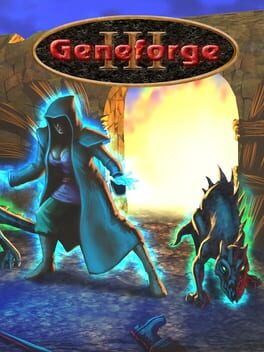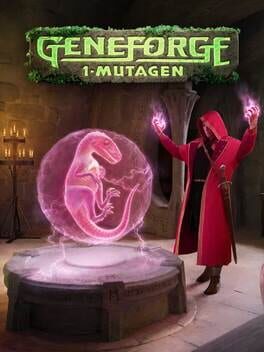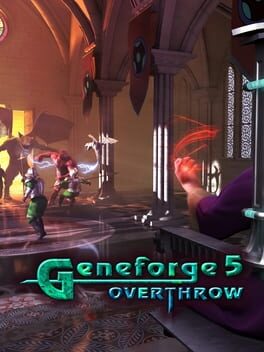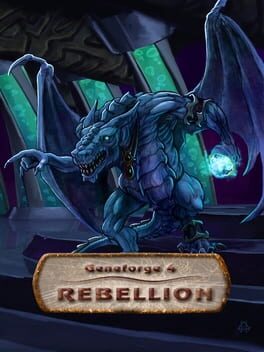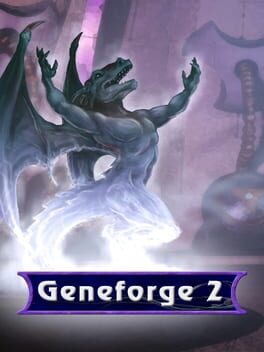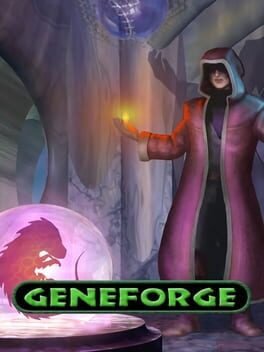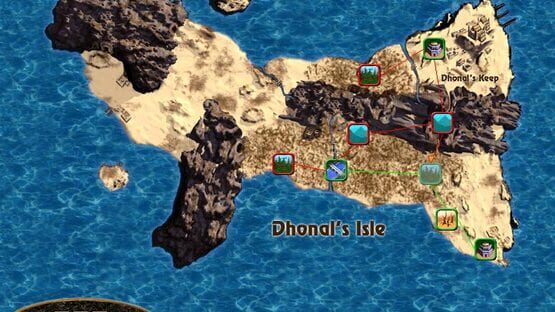

Geneforge 3 is the next, huge installment of the Geneforge saga. In this fantasy adventure, you can explore strange, hostile lands, choose which side you will fight for, and, as always, make your own horde of completely obedient mutant monsters.
Also in series
Reviews View More
This review contains spoilers
One of the most interesting executions of uncomfort within the structure of an RPG. Whilst Geneforge 1 and 2 teased the dysfunction and tension in the Shaper enslavement of their creations, 3 shows this setting finally exploding into the beginnings of a rebellion. The conflict begins immediately as in lieu of a gradual tutorial, your Shaper school is destroyed and you must fight your way out past the wreckage of your home and dead comrades to play the rest of the game. Its an evocative introduction that serves as a microcosm of the overall game's structure of claustrophobia, confusion and chaos.
The Ashen Isles, the setting of Geneforge 3, are noteworthy for two reasons: their linearity and their being part of the core of the Shaper empire. 1 and 2 let players loose within forbidden lands and peripheries beyond Shaper authority. However, your progress within the Ashen Isles is a linear tour through the imploding Shaper core where paranoid and outnumbered authorities have restricted travel and information in a desperate effort to contain the Rising as if its a pandemic. It is a setting pervasive in paranoia and uncertainty where you the Player are constantly deprived of the most valuable tool the series has traditionally offered: choice.
To reach the next island in the chain requires convincing those who control ships to grant you access, whether it be a Shaper or a Rebel. In either case, it means becoming embroiled in the Rebellion. Prior games let you choose your faction but 3 confidently restricts you to two only choices for every dilemma you face: the Shapers or the Rebels. By not presenting a 'third path' or any other nuanced position, the game is better able to make players seriously grapple with its core ethical dilemma: something that's tied in to the content designed for both factions.
Geneforge 3 differs from many other rpgs I've played in the sort of quests it apportions to both factions, something that has made it the most controversial game in the series. To be a rebel means destabilising and eventually overthrowing Shaper control by any means, to the point that civilian casualties become an inevitable side effect of this strategy. Conversely, joining the Shaper empire means simply defending the status quo against the creations spawned to destroy Shaper fortresses and settlements. It takes the traditional rpg quest archetype of defending settlements from monsters and substitutes that fantasy for a messy insurgency. Based on forum readings, choosing to play as Rebels was deemed too unpleasant for many while others criticised the portrayal of Rebels as a cheap strawman of chaotic murderers. Yet the starkness reveals a crucial truth that I don't often see in media concerning rebellion: the inherent inequality in conflicts between the states and insurgents. Its not just that the Empire has a greater industrial capacity and pool of resources to draw upon, rather it is their cultural hegemony that is most crucial. The Shapers have enjoyed unimpeded authority for so long that they have successfully convinced many of their subjects that their power structures are natural rather than unnatural and just rather than unjust. Thus the act of rebellion means not just opposing individual Shapers and their armies but also a wider society that has become comfortable with the Shaper's simple maxim: law and order under our rule, or uncontrollable chaos. To be a creation within this system is to denied even the chance to negotiate with it, only complete subjugation is tolerated. One of the main factions in Geneforge 1 & 2 were the Awakened, a group of people who sincerely believed that creations could co-exist as independent beings alongside Shapers. In a sense they were the closest thing the Geneforge games had to a middle of the road option. They are never mentioned in Geneforge 3, so complete was their destruction at the hands of Shapers. Geneforge 3 is not interested in saving face for the player or offer an ideal compromise, it demands in uncompromising terms that the player either upholds the oppressive system of Shaper control or violently dismantle it.
Indeed, intelligent creations are somewhat invisible for much of Geneforge 3's journey, at least until the last two islands. Rather for the first three islands Geneforge 3 offers a different perspective as you largely interact with a Shaper civil society under deep stress. These communities are paradoxically subject to the absolute authority of Shapers where defiance means death yet are also consistently failed by their Shaper masters and so a diversity of survival strategies begin to emerge influenced by class and space. On Greenwood Isle where your journey begins, it least settled and most marginal of all the Shaper colonies and that lack of deep roots has made local citizens engaged in menial labour more reliant on the few Shaper authorities present on the island and so seek to keep their heads down. For others the isolation traditionally offered a meaningful way to withdraw from Shaper society completely and the Rebel attacks both accentuate and threaten this. Harmony Island is in most respects just as marginal however its swamps hold one valuable resource: herbs vital for Shaper alchemy and magic. Thus, most of the populace are gatherers and farmers, a labour force engaged in work that is harsh, dangerous and poorly rewarded by Shapers at the best of times. And when the Shaper authorities on the island choose to retreat to the main settlement instead of protecting the livelihoods of the populace, revolt becomes their survival strategy thus creating a messy three way conflict on the island. Dhonal's Island is different from these marginal territories, being the affluent capital of the archipelago. Here the Shapers are at their strongest and offer reliable protection to the island's population who are largely involved in empire wide commerce and manufacturing. It is no surprise that the people of Dhonal's Island are most stringent in their support of the Shapers and most hostile towards any act of rebellion. Dhonal's Island are the platonic ideal of the Shaper Empire, a submissive peaceful populace watched over by steadfast wardens, and consequently the most extreme and destabilising acts of the Rebel playthrough take place here. By showing such a diverse array of lived experiences, Geneforge 3 gives context and texture to your choices similarly to how the many pasts of Sucia Island flavoured the player journey in Geneforge 1.
How Geneforge 3 enforces linearity at the expense of the player's convenience to explore how unequal power structures and scarcity of choice create exceptional acts of opposition is easily the best thing about the game. Alas its novel ideas are contrasted by an explorative loop that barely iterates on its predecessors and in some ways actually regresses. Travel between islands is strictly limited to a single poorly drawn boat sprite that only operates for that specific pair of islands. Thus, in the end game travelling between the final island and the third island, something that is required multiple times, means staring at multiple loading screens on top of any uncleared zones. Its a slog that undercut and muddies the elegance of Geneforge's zone system.
The macro and micro level design of these islands is also the least interesting in the series, something that became especially apparent as I moved on to Geneforge 4. In theory, 3's linearity should have created more distinct and focused spaces and journeys. And while each island may have a unique visual identity, I never really had to treat them as unique environments on their own terms. Take the second major location, Harmony Island. It is an inhospitable swamp slowly being flooded with hostile creations yet despite being slightly bigger, the gameplay loop of resolving its problems was identical to the tutorial island. I traversed an indistinct web of zones where I killed hordes of enemies to make them green. The story of Harmony Island, a place where local workers and gatherers had revolted in desperation and frustration at the inability of shapers to protect their meagre homes, was completely divorced from the actual experience of traversing the place. The only exception to this was Dhonal's Island, the embattled and fortified Shaper capital of the archipelago whose attritional and corridor-like geography accentuates the treks through its battlefronts and enemy fortresses to reach the source of hostile creations.
In his famous GDC talk Jeff Vogel noted in relation to Geneforge 3's production that 'he was lazy', that he had slacked off and made something that was too similar to the prior games. That statement is somewhat ironic to me as Geneforge 3 is nothing like its predecessors. Warts and all, it is a singular experience in its deviation from the design language of not just its predecessor but also its own genre. It is restrictive where most rpgs are open, it is disempowering towards the player whereas most rpgs are empowering and uncompromising in the limited choices it doles out to them. And why wouldn't it? I don't think there's a better way to depict the beginnings of a systemic wide rebellion which no individual can truly control, the player included.
The Ashen Isles, the setting of Geneforge 3, are noteworthy for two reasons: their linearity and their being part of the core of the Shaper empire. 1 and 2 let players loose within forbidden lands and peripheries beyond Shaper authority. However, your progress within the Ashen Isles is a linear tour through the imploding Shaper core where paranoid and outnumbered authorities have restricted travel and information in a desperate effort to contain the Rising as if its a pandemic. It is a setting pervasive in paranoia and uncertainty where you the Player are constantly deprived of the most valuable tool the series has traditionally offered: choice.
To reach the next island in the chain requires convincing those who control ships to grant you access, whether it be a Shaper or a Rebel. In either case, it means becoming embroiled in the Rebellion. Prior games let you choose your faction but 3 confidently restricts you to two only choices for every dilemma you face: the Shapers or the Rebels. By not presenting a 'third path' or any other nuanced position, the game is better able to make players seriously grapple with its core ethical dilemma: something that's tied in to the content designed for both factions.
Geneforge 3 differs from many other rpgs I've played in the sort of quests it apportions to both factions, something that has made it the most controversial game in the series. To be a rebel means destabilising and eventually overthrowing Shaper control by any means, to the point that civilian casualties become an inevitable side effect of this strategy. Conversely, joining the Shaper empire means simply defending the status quo against the creations spawned to destroy Shaper fortresses and settlements. It takes the traditional rpg quest archetype of defending settlements from monsters and substitutes that fantasy for a messy insurgency. Based on forum readings, choosing to play as Rebels was deemed too unpleasant for many while others criticised the portrayal of Rebels as a cheap strawman of chaotic murderers. Yet the starkness reveals a crucial truth that I don't often see in media concerning rebellion: the inherent inequality in conflicts between the states and insurgents. Its not just that the Empire has a greater industrial capacity and pool of resources to draw upon, rather it is their cultural hegemony that is most crucial. The Shapers have enjoyed unimpeded authority for so long that they have successfully convinced many of their subjects that their power structures are natural rather than unnatural and just rather than unjust. Thus the act of rebellion means not just opposing individual Shapers and their armies but also a wider society that has become comfortable with the Shaper's simple maxim: law and order under our rule, or uncontrollable chaos. To be a creation within this system is to denied even the chance to negotiate with it, only complete subjugation is tolerated. One of the main factions in Geneforge 1 & 2 were the Awakened, a group of people who sincerely believed that creations could co-exist as independent beings alongside Shapers. In a sense they were the closest thing the Geneforge games had to a middle of the road option. They are never mentioned in Geneforge 3, so complete was their destruction at the hands of Shapers. Geneforge 3 is not interested in saving face for the player or offer an ideal compromise, it demands in uncompromising terms that the player either upholds the oppressive system of Shaper control or violently dismantle it.
Indeed, intelligent creations are somewhat invisible for much of Geneforge 3's journey, at least until the last two islands. Rather for the first three islands Geneforge 3 offers a different perspective as you largely interact with a Shaper civil society under deep stress. These communities are paradoxically subject to the absolute authority of Shapers where defiance means death yet are also consistently failed by their Shaper masters and so a diversity of survival strategies begin to emerge influenced by class and space. On Greenwood Isle where your journey begins, it least settled and most marginal of all the Shaper colonies and that lack of deep roots has made local citizens engaged in menial labour more reliant on the few Shaper authorities present on the island and so seek to keep their heads down. For others the isolation traditionally offered a meaningful way to withdraw from Shaper society completely and the Rebel attacks both accentuate and threaten this. Harmony Island is in most respects just as marginal however its swamps hold one valuable resource: herbs vital for Shaper alchemy and magic. Thus, most of the populace are gatherers and farmers, a labour force engaged in work that is harsh, dangerous and poorly rewarded by Shapers at the best of times. And when the Shaper authorities on the island choose to retreat to the main settlement instead of protecting the livelihoods of the populace, revolt becomes their survival strategy thus creating a messy three way conflict on the island. Dhonal's Island is different from these marginal territories, being the affluent capital of the archipelago. Here the Shapers are at their strongest and offer reliable protection to the island's population who are largely involved in empire wide commerce and manufacturing. It is no surprise that the people of Dhonal's Island are most stringent in their support of the Shapers and most hostile towards any act of rebellion. Dhonal's Island are the platonic ideal of the Shaper Empire, a submissive peaceful populace watched over by steadfast wardens, and consequently the most extreme and destabilising acts of the Rebel playthrough take place here. By showing such a diverse array of lived experiences, Geneforge 3 gives context and texture to your choices similarly to how the many pasts of Sucia Island flavoured the player journey in Geneforge 1.
How Geneforge 3 enforces linearity at the expense of the player's convenience to explore how unequal power structures and scarcity of choice create exceptional acts of opposition is easily the best thing about the game. Alas its novel ideas are contrasted by an explorative loop that barely iterates on its predecessors and in some ways actually regresses. Travel between islands is strictly limited to a single poorly drawn boat sprite that only operates for that specific pair of islands. Thus, in the end game travelling between the final island and the third island, something that is required multiple times, means staring at multiple loading screens on top of any uncleared zones. Its a slog that undercut and muddies the elegance of Geneforge's zone system.
The macro and micro level design of these islands is also the least interesting in the series, something that became especially apparent as I moved on to Geneforge 4. In theory, 3's linearity should have created more distinct and focused spaces and journeys. And while each island may have a unique visual identity, I never really had to treat them as unique environments on their own terms. Take the second major location, Harmony Island. It is an inhospitable swamp slowly being flooded with hostile creations yet despite being slightly bigger, the gameplay loop of resolving its problems was identical to the tutorial island. I traversed an indistinct web of zones where I killed hordes of enemies to make them green. The story of Harmony Island, a place where local workers and gatherers had revolted in desperation and frustration at the inability of shapers to protect their meagre homes, was completely divorced from the actual experience of traversing the place. The only exception to this was Dhonal's Island, the embattled and fortified Shaper capital of the archipelago whose attritional and corridor-like geography accentuates the treks through its battlefronts and enemy fortresses to reach the source of hostile creations.
In his famous GDC talk Jeff Vogel noted in relation to Geneforge 3's production that 'he was lazy', that he had slacked off and made something that was too similar to the prior games. That statement is somewhat ironic to me as Geneforge 3 is nothing like its predecessors. Warts and all, it is a singular experience in its deviation from the design language of not just its predecessor but also its own genre. It is restrictive where most rpgs are open, it is disempowering towards the player whereas most rpgs are empowering and uncompromising in the limited choices it doles out to them. And why wouldn't it? I don't think there's a better way to depict the beginnings of a systemic wide rebellion which no individual can truly control, the player included.
